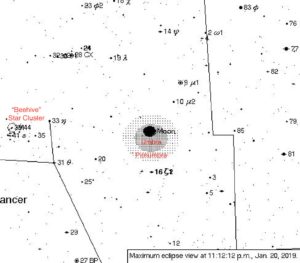JAMESTOWN, N.D. (NewsDakota.com) – Dr. Timothy Bratton is professor emeritus to the University of Jamestown. In his spare time, he enjoys studying the skies above.
As an amateur astronomer, Dr. Bratton has studied and used data to estimate the times of the upcoming Total Lunar Eclipse on January 20th. He says the eclipse will be fully on display for residents to enjoy, compared to the eclipse that occurred in January 2018.
A total lunar eclipse occurs when the Earth’s shadow blocks the sun’s light, which then reflects off the moon. A total eclipse is one of three types of a lunar eclipse.
Dr. Bratton says on Sunday, January 20th this year, there will be a great chance to watch the Total Lunar Eclipse in the area. Dr. Bratton says this eclipse also coincides with the third closest lunar perigee, or approach to the Earth, meaning the moon will be a so-called “Super Moon” or rather only 7% closer to the earth than normal.
Dr. Bratton says the color of the moon during the total eclipse will depend on how much smoke or volcanic ash is in the Earth’s atmosphere.
Dr. Bratton points out that it doesn’t take much to view the lunar eclipse with most being able to watch it without a telescope or binoculars. He encourages anyone who watches it to avoid standing directly under lights and to bundle up with the cold temperatures.
Dr. Bratton has provided a full transcript of estimated times of each event of the eclipse and what will happen during each stage. You can read that below. You can also listen to a full interview with Dr. Timothy Bratton on Let’s Talk About It here.
Sunday, January 20, 2019, 4:55 p.m. CST (Central Standard Time): The Moon rises above our ENE horizon. Luna will be then 99.3% illuminated, 33.28 minutes of arc in apparent diameter, and 222,521 miles distant.
5:20 p.m.: The Sun sets on Jamestown’s WSW horizon.
8:35 p.m.: The eastern (left) rim of the Moon makes contact with the Earth’s penumbra (its fainter outer shadow). You won’t notice anything happening at this stage, but look at the Moon around 9:10 p.m., when it has burrowed far enough into the penumbra that its left edge may look grayer than usual. By this time the Moon might appear as if faint clouds were passing over its surface. Sky & Telescope magazine suggests viewing the Moon through (ironically enough!) sunglasses at this stage of the eclipse; they enhance the contrast between the penumbra and the still bright lunar surface.
9:33:36 p.m.: The center left of the Moon will make contact with the Earth’s darker inner shadow, the umbra. Because the rest of the Moon is still quite bright, the umbra will appear to be a dark gray; any color contrast will become more noticeable as the Moon moves deeper into the umbra. At this time the Moon will be 43 degrees over our city’s ESE horizon and 222,324 miles away.
10:40:48 p.m.: Totality begins as the Moon moves fully into the Earth’s umbra. By this time the Moon will be 52.8 degrees above the ESE-SE skyline and 222,286 miles from Earth. From the Moon’s vantagepoint, the Earth would be eclipsing the Sun; however, enough reddish sunlight would be refracted by and through our planet’s atmosphere that some rays would reach the lunar surface. Anybody on the near side of the Moon would see every sunrise and sunrise on Earth occurring simultaneously; our world would appear to be surrounded by a red ring of fire.
11:12:12 p.m.: This is both the mid-point and maximum of the eclipse, with the Moon 56.7 degrees over the SE horizon and 222,269 miles distant. What color will it be? The “wild cards” this year are any residual smoke from the California and Canadian forest fires and volcanic ash from the eruption of Mt. Aetna in Sicily and volcanoes in Indonesia. In 1963, while living near Cleveland, Ohio, I witnessed a very dark eclipse in which the Moon seemed to disappear from the sky; Mount Agung on the island of Bali had thrown so much ash into the atmosphere that year that only a circular “hole” in the star field indicated where the Moon was hidden from view.
11:16 p.m: Full Moon occurs, with the Moon directly opposite from the hidden Sun and 222,267 miles from Earth. This Full Moon was called the “Snow,” “Hunger,” or “Wolf” Moon by Native Americans, since stored food had run out while deep snow made it difficult to hunt.
11:43:48 p.m.: Totality ends as the Moon’s left rim moves back into the Earth’s penumbra. The duration of totality for this eclipse was one hour and three minutes. By now the Moon will be 59.9 degrees over the SSE horizon and 222,253 miles away. The events of the eclipse now appear to run in reverse order.
12:00:51 a.m., Monday, January 21: The Moon, by now 60.3 degrees above the WSW-W skyline, exits entirely from the Earth’s umbra, through which it passed for 3 hours, 17 minutes, and 24 seconds.
1:49:30 a.m.: The Moon, now 60.3 degrees above the SSW horizon, moves entirely out of the Earth’s penumbra, in which it remained for five hours and 14½ minutes.
8:41:50 a.m.: The Moon sets at Jamestown along our city’s SW-WSW skyline.
3:00 p.m.: The Moon attains its third closest perigee to Earth this year, when it will be just 222,042 miles away, 33.436 minutes of arc in apparent diameter, 99.7% lit, and 21.9 degrees beneath our NNE horizon.
This will be the only lunar eclipse visible to us this year; we will not see any solar eclipses at all. To avoid frostbite, view the Moon at critical stages of the eclipse, particularly the beginning of totality, mid-eclipse, and the end of totality.

“This LodeStar Professional picture shows an area 15 degrees wide centered on the Moon at mid-eclipse. The Moon will be passing just to the north of the middle of the Earth’s umbra.”
